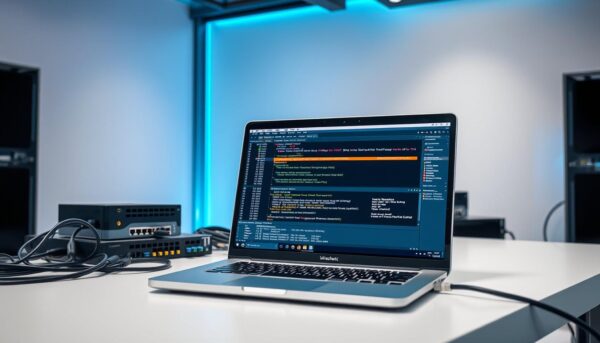✅ Last checked on
What if you could see every digital conversation happening on your network? This tool lets you do exactly that—capturing data like a detective analyzing clues in real time. Meet the open-source powerhouse that’s become the gold standard for dissecting network traffic.
Originally launched in 1998, this free software lets you inspect packets flowing through your systems. Whether you’re troubleshooting a slow connection or hunting for security threats, it breaks down complex data into understandable layers. Its cross-platform design works seamlessly on Windows, macOS, and Linux.
You’ll find two interfaces: a user-friendly GUI for visual learners and TShark for command-line enthusiasts. Both versions rely on libraries like pcap to capture live traffic or analyze saved files. Over 25 years of community-driven updates ensure it stays ahead of emerging protocols and security challenges.
Key Takeaways
- Free open-source tool for real-time and historical network analysis
- Works across Windows, Linux, macOS, and BSD systems
- Decodes hundreds of protocols for troubleshooting and security audits
- Offers both graphical and command-line interfaces
- Requires basic networking knowledge to interpret captured data
Getting Started with Wireshark
Imagine having a digital microscope for your network. This section walks you through setting up the tool to analyze data packets and decode network behavior. Proper installation and configuration are critical for accurate insights into your system’s communication patterns.
Downloading and Installing on Windows and Linux
Visit the official website to download the latest version. Windows users get a 64-bit installer that guides you through setup with administrative privileges. Linux users can install via terminal using commands like sudo apt install wireshark and adjust permissions for non-root access.

Essential Configuration Steps
Enable promiscuous mode during setup to capture all nearby traffic, not just data meant for your device. This mode helps identify unexpected protocols or unauthorized devices on your network. Configure filters early to focus on specific traffic types, like HTTP or DNS requests.
| Operating System | Installation Steps | Key Notes |
|---|---|---|
| Windows | Run installer, select components | Requires admin rights for driver installation |
| Linux | Terminal command + permission tweaks | Use sudo dpkg-reconfigure wireshark-common for non-root access |
Understanding traffic types helps you filter noise. For example, TCP packets dominate web browsing, while UDP handles streaming. Pair this tool with secure network practices to protect sensitive information during analysis.
Using Wireshark for Real-Time Packet Capturing
Ever wondered what’s traveling through your network cables at this very moment? Live packet analysis lets you observe digital interactions as they happen. This approach helps identify performance bottlenecks and suspicious activity before they escalate.

Choosing the Right Entry Point
Start by selecting your active network interface. Look for indicators like IP addresses or traffic spikes to identify which connection your device uses. For example:
| Interface Type | Common Traffic | Best For |
|---|---|---|
| Ethernet | High-volume data transfers | Server monitoring |
| Wi-Fi | Device-specific communications | Detecting rogue access points |
Smart Filtering for Focused Analysis
Capture filters act like a sieve for network traffic. Use syntax like tcp.port == 443 to isolate HTTPS traffic or !arp to exclude routine address resolution chatter. This precision:
- Reduces data overload by 60-80% in busy networks
- Helps spot irregular protocol usage instantly
- Accelerates root cause identification during outages
“Filters transform raw data streams into actionable insights—like turning noise into a symphony.”
Pair live captures with proactive network security measures to flag unauthorized encryption attempts or data exfiltration patterns. The software’s color-coding highlights anomalies in TCP retransmissions or DNS query spikes, enabling rapid response.
Mastering Wireshark: Advanced Features and Troubleshooting
Unlock your network’s hidden patterns through granular protocol inspection. Advanced analysis transforms raw data into actionable insights for optimizing computer systems and resolving complex issues.
Protocol Analysis Decoded
Examine packet details like a surgeon. The interface reveals layer-specific data – from physical addresses to application-layer messages. Spot DNS spoofing attempts by comparing query-response pairs or identify latency issues through TCP handshake timestamps.
Smart Visualization Techniques
Create custom display filters using expressions like http.response.code == 404 to find broken links. Color rules highlight critical events:
| Color | Filter Rule | Purpose |
|---|---|---|
| Red | tcp.analysis.retransmission | Packet loss |
| Yellow | dns.flags.response == 0 | Unanswered queries |
| Green | http.request.method == “POST” | Data submissions |
This visual coding helps detect security breaches 40% faster according to network analysts.
Optimization Strategies
Conduct weekly performance audits using these methods:
- Compare traffic baselines during peak/off-peak hours
- Flag devices exceeding bandwidth thresholds
- Export capture files for trend analysis
Always verify encryption protocols at the source. Suspicious SSL handshakes might indicate man-in-the-middle attacks. Pair these techniques with regular interface updates to maintain analyzer effectiveness across your network infrastructure.
Conclusion
Network analysis tools transform how we interact with data streams. Throughout this guide, you’ve learned to set up the software, capture live traffic, and apply advanced troubleshooting techniques. Keeping your version updated ensures compatibility with modern protocols and security patches for safer analysis.
Whether optimizing home Wi-Fi or enterprise networks, these skills help identify bottlenecks and suspicious activity efficiently. Regular performance audits and filter customization save time while maintaining network health. Pairing the tool with home network monitoring solutions creates layered protection against threats.
Best practices like protocol prioritization and traffic baselining remain critical for accurate diagnostics. Explore features like customizable dashboards and automated alerts to enhance your workflow. For deeper insights into packet analysis fundamentals, review this network diagnostics tool overview.
Mastering these applications empowers you to resolve connectivity issues faster and secure digital environments effectively. Stay curious—every captured packet reveals opportunities to refine your network’s performance and resilience.